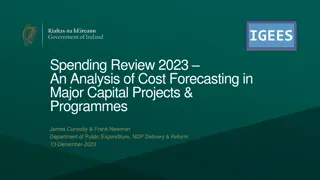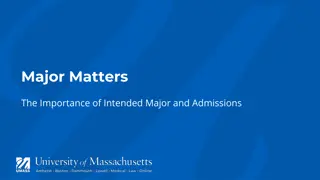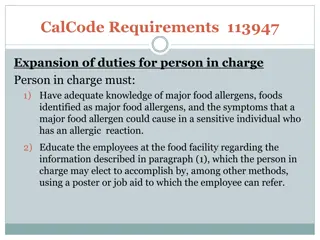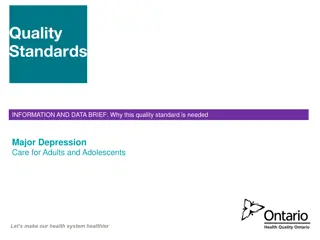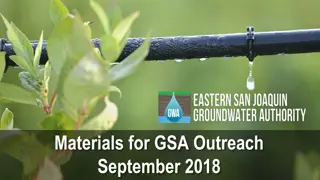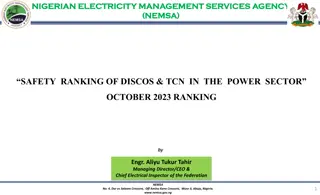
Postal Regulatory Commission Overview
"Learn about the Postal Regulatory Commission (PRC), its mission, composition, strategic plan, and commissioner updates. Understand the role of the PRC in ensuring transparency and efficiency in the United States Postal Service."
Download Presentation

Please find below an Image/Link to download the presentation.
The content on the website is provided AS IS for your information and personal use only. It may not be sold, licensed, or shared on other websites without obtaining consent from the author. If you encounter any issues during the download, it is possible that the publisher has removed the file from their server.
You are allowed to download the files provided on this website for personal or commercial use, subject to the condition that they are used lawfully. All files are the property of their respective owners.
The content on the website is provided AS IS for your information and personal use only. It may not be sold, licensed, or shared on other websites without obtaining consent from the author.
E N D
Presentation Transcript
P O S T A L R E G U L A T O R Y C O M M I S S I O N P O S T A L R E G U L A T O R Y C O M M I S S I O N Major Mailers Association Regulatory Update Mark D. Acton, Commissioner October 19, 2016 10/19/2016 V I E W S O F C O M M I S S I O N E R A C T O N 1
P O S T A L R E G U L A T O R Y C O M M I S S I O N Contents The Postal Regulatory Commission PRC Strategic Plan Postal Pricing for 2017 Exigent Rate Case Status Latest CPI-U Price Cap Authority Compliance FY2015 Annual Compliance Determination Separate Financial Analysis Universal Postal Union Views UPS Proposals 1&2 Proposal 13 First Class Mail Parcels Latest Tech Credit Promotions 2017 Ratemaking Study Reform/Legislative Update Questions & Answers 10/19/2016 V I E W S O F C O M M I S S I O N E R A C T O N 2
P O S T A L R E G U L A T O R Y C O M M I S S I O N The Postal Regulatory Commission Mission Statement: Ensure transparency and accountability of the United States Postal Service and foster a vital and efficient universal mail system Design of Commission Composition: 5 Commissioners, appointed by the President and confirmed by the U.S. Senate this is the full complement Each Commissioner is appointed to 6 year terms Balance of political parties is required there can be no more than 3 Commissioners of one political party 10/19/2016 V I E W S O F C O M M I S S I O N E R A C T O N 3
P O S T A L R E G U L A T O R Y C O M M I S S I O N The Postal Regulatory Commission The Postal Regulatory Commission currently has one vacant Commissioner slot Ruth Goldway s term expired on November 22, 2015 after 18 years of public service Commissioner Tony Hammond s term expires on October 14, 2018 Commissioner Nanci Langley s term expires on November 22, 2018 Acting Chairman Robert Taub s term expired on October 14, 2016 Commissioner Mark Acton s term expired on October 14, 2016 10/19/2016 V I E W S O F C O M M I S S I O N E R A C T O N 4
P O S T A L R E G U L A T O R Y C O M M I S S I O N PRC Strategic Plan for the Next Five Years Developed following a vigorous and inclusive process which incorporated input from all Commission employees: The Strategic Plan identifies four strategic goals, key objectives, and performance indicators to measure progress: Strategic Goal 1: Deliver accurate and objective analyses and decisions to ensure transparency and accountability of the Postal Service. Strategic Goal 2: Actively engage with Congress and stakeholders in support of a dynamic postal system. Strategic Goal 3: Provide an optimal internal infrastructure to support management of priorities, workload, and emerging requirements. Strategic Goal 4: Recruit, develop, and retain a diverse, high-performing workforce. 10/19/2016 V I E W S O F C O M M I S S I O N E R A C T O N 5
P O S T A L R E G U L A T O R Y C O M M I S S I O N Postal Pricing 2017 On October 12, the Postal Service announced new prices to take effect on January 22, 2017 Single-piece First-Class Mail postage will rise from 47 cents to 49 cents The one-ounce Metered Mail price will decrease from 46.5 cents to 46 cents Some First-Class Mail Presort prices will decrease, while others will increase FSS pricing will be removed; mailers will pay for flats based on volume density, without regard to what equipment the flats are processed on Standard Mail will be rebranded as Marketing Mail The Commission will review the proposal for compliance with the law and will issue a decision in late November 10/19/2016 V I E W S O F C O M M I S S I O N E R A C T O N 6
P O S T A L R E G U L A T O R Y C O M M I S S I O N Exigent Rate Case As of April 10, 2016, the USPS has collected the entirety of its temporary exigent surcharge on monopoly products. The Postal Service, with the additional $1.191 billion directed by the Court, recovered a total exigent surcharge of $3.957 billion in contribution 10/19/2016 V I E W S O F C O M M I S S I O N E R A C T O N 7
P O S T A L R E G U L A T O R Y C O M M I S S I O N Exigent Rate Case Status On August 27, 2015, the Postal Service filed notice with the U.S. Court of Appeals for the D.C. Circuit that it was appealing the Commission s order on remand for the exigent decision issued at the end of last July (R2013- 11R) 10/19/2016 V I E W S O F C O M M I S S I O N E R A C T O N 8
P O S T A L R E G U L A T O R Y C O M M I S S I O N Exigent Rate Case Status The Postal Service identifies the issue on appeal as [w]hether the Postal Regulatory Commission s method of computing the mail volume and contribution lost due to either extraordinary or exceptional circumstances . . . is inconsistent with the test that this Court upheld in Alliance of Nonprofit Mailers, et al. v. Postal Regulatory Commission . . . or is otherwise arbitrary, capricious, or an abuse of discretion. Oral arguments were conducted in September, and a decision will likely be rendered soon 10/19/2016 V I E W S O F C O M M I S S I O N E R A C T O N 9
P O S T A L R E G U L A T O R Y C O M M I S S I O N Latest CPI-U Price Cap Authority (As of September 2016) 12-Month Average Change in CPI-U Prepared by the Postal Regulatory Commission Last Update: 09/16/2016 Year 2005 2006 2007 2008 2009 2010 2011 2012 2013 2014 2015 Jan Feb Mar Apr May Jun Jul Aug Sep Oct Nov Dec 2.8% 3.5% 3.1% 3.0% 3.5% -0.143% 1.559% 3.263% 1.960% 1.464% 1.483% 2.9% 3.5% 3.0% 3.2% 3.2% 0.013% 1.557% 3.326% 1.887% 1.393% 1.386% 3.0% 3.5% 2.9% 3.3% 2.8% 0.236% 1.589% 3.322% 1.789%6/ 1.396% 1.253% 3.1% 3.5% 2.8% 3.4% 2.4% 0.482% 1.668% 3.248% 1.686% 1.471% 1.072% 3.1% 3.7% 2.7% 3.5% 1.9% 0.757% 1.799% 3.090% 1.657% 1.535% 0.891% 3.0% 3.8% 2.6% 3.7% 1.4% 0.968% 2.008% 2.930% 1.664% 1.562% 0.728% 3.0% 3.9% 2.4% 4.0% 0.8% 1.252% 2.208% 2.743% 1.710% 1.565% 0.576% 3.1% 3.9% 2.3% 4.3% 0.2% 1.477% 2.426%4/ 2.570%5/ 1.696%7/ 1.580% 0.451% 3.3% 3.7% 2.3% 4.4% -0.324% 1.685% 2.653% 2.415% 1.628% 1.620% 0.311%9/ 3.4% 3.4% 2.5% 4.5% -0.634% 1.799% 2.849% 2.303% 1.528% 1.678% 0.187% 3.4% 3.3% 2.7% 4.2% -0.570% 1.741%3/ 3.036% 2.170% 1.484% 1.685%8/ 0.120% 3.4% 3.2% 2.9%1/ 3.8%2/ -0.356% 1.640% 3.157% 2.069% 1.465% 1.622% 0.119% 2016 0.239% 0.325% 0.402%10/ 0.513% 0.602% 0.676% 0.731% 0.804% 1/ Price Cap for Docket No. R2008-1 7/ Price Cap for First-Class Mail, Standard Mail, Periodicals, and Package Services for Docket No. R2013-10; 2/ Price Cap for Docket No. R2009-2 Partial Year Price Cap for Special Services for Docket No. R2013-10 equals 0.636 percent 3/ Price Cap for Docket No. R2011-2 8/ Price Cap for Docket No. R2015-4, Interim Unused Rate Adjustment Authority equals 0.281 percent 4/ Partial Year Price Cap for Docket No. R2012-3 equals 2.133 percent 9/ Partial Year Price Cap for First-Class Mail and Standard Mail for Docket No. R2016-2 equals 0.064 percent 5/ Price Cap for Docket No. R2013-1 10/ Partial Year Price Cap for First-Class Mail and Standard Mail for Docket No. R2016-5 equals 0.384 percent 6/ Partial Year Price Cap for Special Services for Docket No. R2013-7 equals 1.053 percent Explanation of How "Change in CPI-U" is Calculated: The Commission determines the price cap for any 12-month period by calculating the ratio of two 12-month CPI-U averages that are 12 months apart, subtracting one, and expressing the value as a percentage. For a more detailed explanation of the calculation of the price cap please see 39 CFR 3010.21. 10/19/2016 V I E W S O F C O M M I S S I O N E R A C T O N 10
P O S T A L R E G U L A T O R Y C O M M I S S I O N Compliance: Annual Compliance Determination On March 28, 2016, the Commission issued its FY 2015 Annual Compliance Determination This report is issued by the Postal Regulatory Commission (PRC) in response to the Annual Compliance Report submitted by USPS to the PRC each fiscal year PRC determines whether any price or fee in effect during the year under review was not in compliance with applicable provisions and whether any service standards were not met 10/19/2016 V I E W S O F C O M M I S S I O N E R A C T O N 11
P O S T A L R E G U L A T O R Y C O M M I S S I O N Compliance: Annual Compliance Determination Principal Findings for FY 2015 include: The majority of products failed to meet service performance targets for FY 2015. Service performance results for all First-Class Mail products did not meet their targets The Commission determined that First-Class Mail Single-Piece Letters/Postcards were not in compliance in FY 2015, and directed the Postal Service to improve service performance and provide a comprehensive plan within 90 days Seven noncompensatory Market Dominant products are identified: Periodicals In-County, Periodicals Outside County, Standard Flats, Standard Parcels, Media Mail/Library Mail, Inbound Letter Post, and Stamp Fulfillment Services 10/19/2016 V I E W S O F C O M M I S S I O N E R A C T O N 12
P O S T A L R E G U L A T O R Y C O M M I S S I O N Compliance: Annual Compliance Determination Principal Findings for FY 2015, continued: Revenues for six competitive products: Priority Mail Contract 135; Parcel Return Service Contract 8; International Money Transfer Service (IMTS) Inbound; IMTS Outbound; Inbound Parcel Post (at UPU rates); and Inbound Air Parcel Post (at non-UPU rates) failed to cover attributable cost and therefore did not comply with section 3633(a)(2). The Commission directed the Postal Service to take corrective action. This year s review of flat-shaped mail shows results for these products remained substantially below their targets, and in all but one case, the performance results declined In FY 2015 the attributable costs of two products consisting of flats, Outside County Periodicals and Standard Mail Flats, combined to exceed revenues by over $1 billion. 10/19/2016 V I E W S O F C O M M I S S I O N E R A C T O N 13
P O S T A L R E G U L A T O R Y C O M M I S S I O N Compliance: Financial Analysis Report Separated from the ACD for the third consecutive year for greater clarity and transparency Includes a more in-depth discussion of the cost savings the Postal Service has generated, the financial impact of the various classes of mail, and a review of its assets and liabilities 10/19/2016 V I E W S O F C O M M I S S I O N E R A C T O N 14
P O S T A L R E G U L A T O R Y C O M M I S S I O N Compliance: Financial Analysis Report Findings include: At the end of FY 2015, the Postal Service s total liabilities exceeded the total value of its assets by $50.4 billion. This results from several years of net operating losses starting in FY 2007. Although FY 2014 and FY 2015 had a net operating income, the slow replacement of fully depreciated capital assets and substantial personnel related liabilities also contributed to this high net deficiency. Total liabilities increased by $6.8 billion dollars, mainly due to the Postal Service s non-payment of its RHBF statutory obligation and increases in workers compensation liability. 10/19/2016 V I E W S O F C O M M I S S I O N E R A C T O N 15
P O S T A L R E G U L A T O R Y C O M M I S S I O N Compliance: Financial Analysis Report In FY 2015, the Postal Service generated its second consecutive annual net operating income Negative net worth indicates that the Postal Service has spent both its initial capital and the debt borrowed from the Federal Financing Bank. Simply put, its debts are no longer secured by its assets. The Postal Service has no further access to borrowing under current law 10/19/2016 V I E W S O F C O M M I S S I O N E R A C T O N 16
P O S T A L R E G U L A T O R Y C O M M I S S I O N Universal Postal Union Views The Postal Regulatory Commission has provided its Views as required under 39 U.S.C. 407(c) to the U.S. Department of State regarding the compliance of UPU proposed rates with the standards and criteria under 39 U.S.C. 3622 The Commission must weigh the proposed rates against the nine objectives and 14 factors in 3622, among other things, to determine compliance 10/19/2016 V I E W S O F C O M M I S S I O N E R A C T O N 17
P O S T A L R E G U L A T O R Y C O M M I S S I O N Universal Postal Union Views The Commission reached no majority view (tied vote 2-2) as to whether or not the five proposals to amend rates for Inbound Letter Post were consistent with applicable standards and criteria. I provided my separate views as to why I believe these five rate proposals are not consistent with the applicable standards and criteria established by the Commission. 10/19/2016 V I E W S O F C O M M I S S I O N E R A C T O N 18
P O S T A L R E G U L A T O R Y C O M M I S S I O N Universal Postal Union Views It appears sure to me that despite years of Postal Service efforts and Commission concern in addressing the plain inequities that exist in the present UPU rate setting approach, meaningful systematic reform at the UPU level appears no nearer at hand today than it was eight or even four years past. For me, the notion that today the American consumer can find online the same item delivered from overseas at a rate significantly less than from, say Dallas, speaks powerfully to this fundamental injustice. 10/19/2016 V I E W S O F C O M M I S S I O N E R A C T O N 19
P O S T A L R E G U L A T O R Y C O M M I S S I O N Universal Postal Union Views If a more market-centric resolution cannot be brokered within the UPU, perhaps a coordinated member state initiative without the UPU offers a brighter, longer term prospect toward driving fuller cost coverage and reducing unfair trade distortions. 10/19/2016 V I E W S O F C O M M I S S I O N E R A C T O N 20
P O S T A L R E G U L A T O R Y C O M M I S S I O N Periodic Reporting UPS Proposals One, Two, and Three (Docket No. RM2016-2) On September 9, 2016, the Commission issued a decision on 3 proposals submitted by UPS to change the Postal Service s costing methodologies: The Commission declined to adopt Proposals One and Two because neither improve the quality, accuracy, and completeness of cost attribution (no causal relationship) The Commission DID adopt product and class-level incremental costs as attributable costs and will require the Postal Service to provide enhanced reporting on cost components to facilitate further analysis The Commission declines to consider Proposal Three as it relates to the Commission s 10 year review in 2017 (Institutional Cost percentage) 10/19/2016 V I E W S O F C O M M I S S I O N E R A C T O N 21
P O S T A L R E G U L A T O R Y C O M M I S S I O N Proposal Thirteen (Analytic Principle/Cost Attribution) On October 29, 2015, the PRC approved a modified version of a Postal Service petition seeking consideration of Proposal Thirteen, which describes an updated approach to developing estimates of city carrier street time costs and presents a cost model to implement the proposed approach The PRC found that USPS Proposal Thirteen improves the quality, accuracy, and completeness of the data presented in the Postal Service s periodic reports to the Commission The data improvements include replacing data from the Street Time Study with more recent data and providing more accurate estimates of mail shape variabilities 10/19/2016 V I E W S O F C O M M I S S I O N E R A C T O N 22
P O S T A L R E G U L A T O R Y C O M M I S S I O N Proposal Thirteen The Commission found also that UPS s proposed concept of a single, unified delivery model warrants further consideration Due to concerns regarding measurement error and data reliability (imputation problems), the Commission concludes that UPS s model does not offer greater improvement to the quality, accuracy, or completeness of data than Proposal Thirteen Accordingly, tied to its approval of Proposal Thirteen, the Commission directed the Postal Service to file a data development report 10/19/2016 V I E W S O F C O M M I S S I O N E R A C T O N 23
P O S T A L R E G U L A T O R Y C O M M I S S I O N First-Class Mail Parcels (MC2015-7) On August 26, the PRC denied without prejudice the Postal Service s requested transfer of First-Class Mail Parcels to the Competitive Products list This product transfer was denied on a 3-2 bipartisan vote In my view, common sense alone would seem to dictate that as a parcel, evident in the product s very name, this product may indeed be part of the broader, competitive parcel market. The Commission however, as a regulatory body, requires a proper and thorough evidentiary record consistent with applicable law to support such an analysis and finding, and this was lacking in the course of this filing. USPS has brought suit appealing the Commission s decision in DC Circuit Court of Appeals 10/19/2016 V I E W S O F C O M M I S S I O N E R A C T O N 24
P O S T A L R E G U L A T O R Y C O M M I S S I O N Latest Promotions On May 16, 2016, the Postal Service filed with the Commission seeking approval for six promotions to be held during the 2017 calendar year. One promotion is new, while five are continuations of calendar year 2015 promotions The new promotion is the Direct Mail Starter Promotion This promotion is designed to encourage small business mailers to send direct mail pieces that include technology such as a QR code, for an up front 5 percent postage discount It will run from May 2017 to July 2017 10/19/2016 V I E W S O F C O M M I S S I O N E R A C T O N 25
P O S T A L R E G U L A T O R Y C O M M I S S I O N Latest Promotions The five continued promotions are: Earned Value Reply Mail Promotion (January 2017 June 2017) Tactile, Sensory, and Interactive Mailpiece Engagement Promotion (February 2017 July 2017) Emerging and Advanced Technology Promotion (March 2017 August 2017) Personalized Color Transpromo Promotion (July 2017 December 2017) Mobile Shopping Promotion (August 2017 December 2017) The Commission approved the promotions on June 16, 2016 10/19/2016 V I E W S O F C O M M I S S I O N E R A C T O N 26
P O S T A L R E G U L A T O R Y C O M M I S S I O N 2017 Ratemaking Study As per the 2006 Postal Accountability and Enhancement Act, the PRC is required to review the system for regulating rates and classes for market-dominant products ten years after the date of enactment of that legislation (which would be December 20, 2016) Title 39, Sec. 3622(d)(3): 10/19/2016 V I E W S O F C O M M I S S I O N E R A C T O N 27
P O S T A L R E G U L A T O R Y C O M M I S S I O N 2017 Ratemaking Study Ten years after the date of enactment of the Postal Accountability and Enhancement Act and as appropriate thereafter, the Commission shall review the system for regulating rates and classes for market-dominant products established under this section to determine if the system is achieving the objectives in subsection (b), taking into account the factors in subsection (c). If the Commission determines, after notice and opportunity for public comment, that the system is not achieving the objectives in subsection (b), taking into account the factors in subsection (c), the Commission may, by regulation, make such modification or adopt such alternative system for regulating rates and classes for market-dominant products as necessary to achieve the objectives. 10/19/2016 V I E W S O F C O M M I S S I O N E R A C T O N 28
P O S T A L R E G U L A T O R Y C O M M I S S I O N 2017 Ratemaking Study The Commission is required by law to consider 9 objectives, while taking into account 14 factors, as described in the previous slide Taken together, these multiple considerations may suggest a balanced approach, and that no one factor or objective may necessarily result in a change In 2016, the Commission plans internal preparations 10/19/2016 V I E W S O F C O M M I S S I O N E R A C T O N 29
P O S T A L R E G U L A T O R Y C O M M I S S I O N 2017 Ratemaking Study 9 Objectives: (1) To maximize incentives to reduce costs and increase efficiency. (2) To create predictability and stability in rates. (3) To maintain high quality service standards established under section 3691. (4) To allow the Postal Service pricing flexibility. (5) To assure adequate revenues, including retained earnings, to maintain financial stability. (6) To reduce the administrative burden and increase the transparency of the ratemaking process. (7) To enhance mail security and deter terrorism. (8) To establish and maintain a just and reasonable schedule for rates and classifications, however the objective under this paragraph shall not be construed to prohibit the Postal Service from making changes of unequal magnitude within, between, or among classes of mail. (9) To allocate the total institutional costs of the Postal Service appropriately between market-dominant and competitive products. 10/19/2016 V I E W S O F C O M M I S S I O N E R A C T O N 30
P O S T A L R E G U L A T O R Y C O M M I S S I O N 2017 Ratemaking Study 14 Factors: (1) the value of the mail service actually provided each class or type of mail service to both the sender and the recipient, including but not limited to the collection, mode of transportation, and priority of delivery; (2) the requirement that each class of mail or type of mail service bear the direct and indirect postal costs attributable to each class or type of mail service through reliably identified causal relationships plus that portion of all other costs of the Postal Service reasonably assignable to such class or type; (3) the effect of rate increases upon the general public, business mail users, and enterprises in the private sector of the economy engaged in the delivery of mail matter other than letters; (4) the available alternative means of sending and receiving letters and other mail matter at reasonable costs; (5) the degree of preparation of mail for delivery into the postal system performed by the mailer and its effect upon reducing costs to the Postal Service; (6) simplicity of structure for the entire schedule and simple, identifiable relationships between the rates or fees charged the various classes of mail for postal services; (7) the importance of pricing flexibility to encourage increased mail volume and operational efficiency; (8) the relative value to the people of the kinds of mail matter entered into the postal system and the desirability and justification for special classifications and services of mail; (continued on next slide) 10/19/2016 V I E W S O F C O M M I S S I O N E R A C T O N 31
P O S T A L R E G U L A T O R Y C O M M I S S I O N 2017 Ratemaking Study 14 Factors (cont d): (9) the importance of providing classifications with extremely high degrees of reliability and speed of delivery and of providing those that do not require high degrees of reliability and speed of delivery; (10) the desirability of special classifications for both postal users and the Postal Service in accordance with the policies of this title, including agreements between the Postal Service and postal users, when available on public and reasonable terms to similarly situated mailers, that (A) either (i) improve the net financial position of the Postal Service through reducing Postal Service costs or increasing the overall contribution to the institutional costs of the Postal Service; or (ii) enhance the performance of mail preparation, processing, transportation, or other functions; and (B) do not cause unreasonable harm to the marketplace. (11) the educational, cultural, scientific, and informational value to the recipient of mail matter; (12) the need for the Postal Service to increase its efficiency and reduce its costs, including infrastructure costs, to help maintain high quality, affordable postal services; (13) the value to the Postal Service and postal users of promoting intelligent mail and of secure, sender-identified mail; and (14) the policies of this title as well as such other factors as the Commission determines appropriate. 10/19/2016 V I E W S O F C O M M I S S I O N E R A C T O N 32
P O S T A L R E G U L A T O R Y C O M M I S S I O N 2017 Ratemaking Study The Chairman has set the following schedule for the 10 year Ratemaking Study: December 20, 2016 Commission issues Order beginning the review. The Order will describe the approximate structure and timeframe within which the Commission will complete its review, as well as define the opportunities for public comment within the review Early Spring 2017 Deadline for comments to be submitted Early Autumn 2017 Commission issues Order including its findings and, if necessary, preparatory rule-making information for any changes to the system 10/19/2016 V I E W S O F C O M M I S S I O N E R A C T O N 33
P O S T A L R E G U L A T O R Y C O M M I S S I O N Legislative Update On September 17, 2015 Senate Homeland Security and Governmental Affairs Committee Ranking Member, Sen. Tom Carper, introduced reform legislation, S. 2051, the Improving Postal Operations, Service, and Transparency Act of 2015 Sens. Jerry Moran (R-Kan.), Claire McCaskill (D-Mo.), Roy Blunt (R-Mo.) Susan Collins (R-ME) have cosponsored the legislation Broader question is whether targeted legislative changes are more passable than broad legislative reform Some agree a combination of re-amortization of USPS retiree health benefits prepayments, and the ability to administer its own health care plan would put USPS in a sustainable financial position 10/19/2016 V I E W S O F C O M M I S S I O N E R A C T O N 34
P O S T A L R E G U L A T O R Y C O M M I S S I O N Legislative Update On July 8 Chairman Jason Chaffetz (R-UT) and Ranking Member Elijah Cummings (D-MD) HR 5714 introduced the bipartisan House postal reform bill This bill would legislate a postage rate increase equal to half of the 4.3 percent temporary exigent surcharge that expired on April 10 Contains Medicare integration that it hopes will save the Postal Service over $50 billion in retiree health benefit costs Await CBO scoring This bill may be the best chance for reform in the coming months (and years) 10/19/2016 V I E W S O F C O M M I S S I O N E R A C T O N 35
P O S T A L R E G U L A T O R Y C O M M I S S I O N Legislative Update Factors (+) favoring/ (-) not favoring reform? (+) Reform of some form is needed! (-) In 2015, the Postal Service had its second consecutive operational profit since 2008, and Quarter 1 of FY 2016 was profitable as well. This may impact the chances of reform, as USPS circumstance seem less dire (-) Extended temporary exigent surcharge (-) Lame Duck session 10/19/2016 V I E W S O F C O M M I S S I O N E R A C T O N 36
P O S T A L R E G U L A T O R Y C O M M I S S I O N P O S T A L R E G U L A T O R Y C O M M I S S I O N QUESTIONS? WWW.PRC.GOV 10/19/2016 V I E W S O F C O M M I S S I O N E R A C T O N 37


